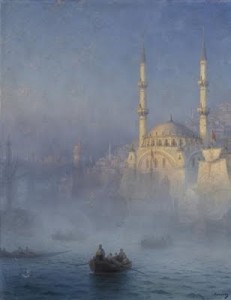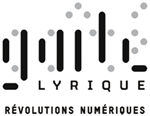 Alors que Paris en pince pour Renoir sous la Grande Verrière du Grand Palais, je vous signale l’exposition sur Byzance, au même endroit. 500 objets et œuvres d’art y racontent l’aventure de cette « Sublime Porte » entre l’Asie et l’Occident. Les grands moments d’une cité invraisemblable à plus d’un titre (successivement grecque, romaine, chrétienne et musulmane…) sont montrés avec une rare pertinence. Tout comme le quotidien des humbles gens, nourris gratuitement, le saviez-vous, pendant des siècles durant, par leurs sultans et empereurs successifs (on n’a finalement rien inventé avec notre RSA !).
L’exposition met particulièrement en valeur les arts militaires et somptuaires de la civilisation byzantine dont le raffinement en fit l’une des plus belles de la Renaissance.
Byzance fut, en effet, LE carrefour multiculturel par excellence dont l’effervescence brouillonne et sublime contrastait avec les normes univoques d’Athènes et de Rome. Rapporté à 2009, Byzance ce serait un peu Berlin l’Alternative contre Paris La Sorbonne. Stèles funéraires, manuscrits, gravures, parures, ustensiles quotidiens, livres, icônes et installations, tout, dans cette exposition, signe le grand destin de Byzance-Constantinople-Istanbul. Figurez-vous qu’en creusant le tunnel sous-marin du métro d’Istanbul on vient de mettre à jour rien de moins que l’ancien port de Théodose. Une telle découverte confirme que Byzance fut maritime avant de devenir continentale. L’importance majeure de l’exposition Byzance au Grand Palais n’a pas échappé aux plus hautes autorités. Elle a directement été placée sous le haut patronage de Nicolas Sarkozy et de Abdullah Gül, Président de la République de Turquie. Peut-être ont-ils évoqué, à cette occasion, les futurs liens de l’Europe avec une capitale dont le destin reste toujours une énigme à écrire.
Alors que Paris en pince pour Renoir sous la Grande Verrière du Grand Palais, je vous signale l’exposition sur Byzance, au même endroit. 500 objets et œuvres d’art y racontent l’aventure de cette « Sublime Porte » entre l’Asie et l’Occident. Les grands moments d’une cité invraisemblable à plus d’un titre (successivement grecque, romaine, chrétienne et musulmane…) sont montrés avec une rare pertinence. Tout comme le quotidien des humbles gens, nourris gratuitement, le saviez-vous, pendant des siècles durant, par leurs sultans et empereurs successifs (on n’a finalement rien inventé avec notre RSA !).
L’exposition met particulièrement en valeur les arts militaires et somptuaires de la civilisation byzantine dont le raffinement en fit l’une des plus belles de la Renaissance.
Byzance fut, en effet, LE carrefour multiculturel par excellence dont l’effervescence brouillonne et sublime contrastait avec les normes univoques d’Athènes et de Rome. Rapporté à 2009, Byzance ce serait un peu Berlin l’Alternative contre Paris La Sorbonne. Stèles funéraires, manuscrits, gravures, parures, ustensiles quotidiens, livres, icônes et installations, tout, dans cette exposition, signe le grand destin de Byzance-Constantinople-Istanbul. Figurez-vous qu’en creusant le tunnel sous-marin du métro d’Istanbul on vient de mettre à jour rien de moins que l’ancien port de Théodose. Une telle découverte confirme que Byzance fut maritime avant de devenir continentale. L’importance majeure de l’exposition Byzance au Grand Palais n’a pas échappé aux plus hautes autorités. Elle a directement été placée sous le haut patronage de Nicolas Sarkozy et de Abdullah Gül, Président de la République de Turquie. Peut-être ont-ils évoqué, à cette occasion, les futurs liens de l’Europe avec une capitale dont le destin reste toujours une énigme à écrire.
Ambiguous Byzantium
While all Paris is talking about the Renoir exhibition currently showing under the glass roof of the Grand Palais, I would like to bring your attention to the exhibition on Byzantium at the same gallery. There you can discover 500 objects and works of art telling the story of this ‘Sublime Gateway’ between Asia and the West. The great moments of a city that was special in many ways (successively Greek, Roman, Christian and Muslim…) are shown with a rare pertinence. As are the everyday lives of its humble people who were fed for free (did you know that?) for centuries by their sultans and emperors (finally our welfare system is nothing new!). The exhibition pays particular attention to the sumptuous military arts of the Byzantine civilisation which was one of the most sophisticated of the Renaissance. Byzantium was, effectively, THE multicultural crossroads with a splendidly random effervescence which contrasted sharply with the univocal norms of Athens and Rome. In 2009 terms, Byzantium is a bit like Alternative Berlin compared to Sorbonne Paris. Funereal steles, manuscripts, engravings, jewels, everyday utensils, books, icons and installations, everything in this exhibition symbolises the great destiny of Byzantium-Constantinople-Istanbul. And, while digging the underwater section of the tunnel for the Istanbul underground line, workers stumbled upon nothing less than the remnants of the ancient port of Theodosius. This discovery confirms that Byzantium was a maritime city before becoming continental. The major importance of the exhibition on Byzantium at the Grand Palais has not escaped the highest authorities and it has directly been placed under the high patronage of Nicolas Sarkozy and Abdullah Gul, President of the Republic of Turkey. Maybe it gave them the opportunity to discuss future links between Europe and a capital whose destiny remains an enigma still to be written.
Exposition « De Byzance à Istanbul, un port pour deux continents »
Grand Palais du 10 octobre 2009 au 25 janvier 2010.
Ouvert Tous les jours de 10h à 20h, nocturne le mercredi jusqu’à 22h, fermeture le mardi.
Plein tarif : 11€ – Tarif réduit : 8€
Didier MOINEL DELALANDE




